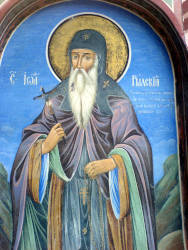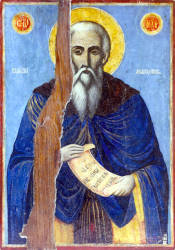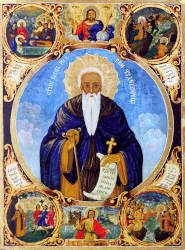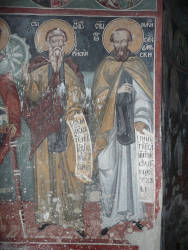Cave of St. Ivan Rilski
Useful Information


| Location: |
Skrino.
Motorway M1 south of Sophia, exit Boboshevo, to Boboshevo, after the bridge turn left the straight ahead to Skrino. In Skrino turn left, signposted. (42.175354, 22.947732) |
| Open: |
no restrictions. [2021] |
| Fee: |
free. [2021] |
| Classification: |
 Cave Church Cave Church
|
| Light: | n/a |
| Dimension: | Ø=3m. |
| Guided tours: | self guided |
| Photography: | allowed |
| Accessibility: | no |
| Bibliography: | |
| Address: | Ruen Monastery "Sv. Ivan Rilski", 2663 Skrino |
| As far as we know this information was accurate when it was published (see years in brackets), but may have changed since then. Please check rates and details directly with the companies in question if you need more recent info. |
|
History
| 876 | St. Ivan Rilski born at Skrino. |
| 901 | St. Ivan Rilski becomes a novice in the monastery St. Dimitar (St. Dimitrii monastery). |
Description


This пещера на свети Иван Рилски (Cave of St. Ivan Rilski) is located near the Руенски манастир „Свети Йоан Рилски“ (Ruen Monastery "Sv. Ivan Rilski"), about 10 minutes walk on the trail to Връх Бобошевски Руен (Boboshevski Ruen peak, 1,134 m asl) in Vlahina mountain. In the cave there is a natural altar with candles and icons, where the saint is worshipped. The cave is pretty small, only about 3m in diameter, and actually not worth the trip. It is only interesting if you are in the area, or a real fan of Saint Ivan.
Св. Иван Рилски (St. Ivan Rilski) was born in the village of Skrino in 876. Until the age of 25 he was a shepherd, but then his parents died. He gave up everything and donated his inheritance to poor and sick people. Then he became a novice in the monastery St. Dimitar (St. Dimitrii monastery) at the foot of mount Ruen. He received a clerical rank and accepted monasticism. He devoted himself to fasting and prayer, and first served in Vitosha Mountain, then in Rila, before the famous monastery was built. He spent 20 years in solitude, praying to God amd eating only herbs and fruits. His reputation as a healer spread and many sick people came to him to be healed from diseases and mental anguish. And he performed many miracles. Spiritual young people began to come to him, who wanted to become his disciples. He lived seven years in the cave, which is also called the Свещената дупка на праведника (Sacred Hole of the Righteous). The ascetic made his disciples to vow not to kill animals and not to eat meat. This rule has been valid for all monks since the construction of the Rila Monastery. St. Ivan Rilski died at the age of 70 in 946.
So the Saint actually was born in the nearby village and lived here for 25 years, and this is the monastery where he was ordained. The monastery is still used as a monastery and was completely renovated, but there is not much of historic buildings or artworks. The cave is very small, and it is not even clear if the Saint actually used the cave. The documented hermits’ life he conducted was later at Rila, in another cave of the same name. Nevertheless, the cave is the reason why many Bulgarians visit the site. It is not always clear if they just mix them up, because they have the same name. There are several pages on the web which show images of this cave but describe the cave at Rila, which adds to the confusion.
The cave is extremely small, only a single room with a diameter of about 3 m. It was heavily altered with a wall on one side which seems to stabilize the cliff face, probably due to rockfall. There is also a stone staircase to the cave entrance. The altar inside is a natural rock, a part of the cave wall, which was probably sculpted to create a level top surface. On the altar is an icon of the Saint, and outside a cast iron relief, also depicting Saint Ivan.
- See also
 Search DuckDuckGo for "Cave of St. Ivan Rilski Skrino"
Search DuckDuckGo for "Cave of St. Ivan Rilski Skrino" Google Earth Placemark
Google Earth Placemark Cave of St.Ivan Rilski (visited: 20-AUG-2021)
Cave of St.Ivan Rilski (visited: 20-AUG-2021) The Cave of St. Ivan Rilski - village of Skrino (visited: 20-AUG-2021)
The Cave of St. Ivan Rilski - village of Skrino (visited: 20-AUG-2021) The Cave of St Ivan of Rila (visited: 20-AUG-2021)
The Cave of St Ivan of Rila (visited: 20-AUG-2021) Край Бобошево: Руенски манастир, връх Бобошевски Руен, църква Св. Тодор и Бобошевски манастир
Край Бобошево: Руенски манастир, връх Бобошевски Руен, църква Св. Тодор и Бобошевски манастир
 (visited: 20-AUG-2021)
(visited: 20-AUG-2021)
 Index
Index Topics
Topics Hierarchical
Hierarchical Countries
Countries Maps
Maps